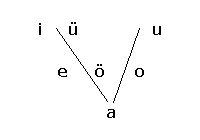Vowel trapezoid
| Vowels | ||||||||||||||||||
|---|---|---|---|---|---|---|---|---|---|---|---|---|---|---|---|---|---|---|
|
||||||||||||||||||
|
For pairs of symbols (u • g) the left symbol stands for the unrounded vowel, the right symbol for the rounded vowel. |
||||||||||||||||||
The vowel trapezoid is a visual representation of the phonetic vowel systems of a language.
The two dimensions of the trapezoid (a schematic oral cavity ) form two basic articulatory dimensions of the vowels from: the horizontal stands for the front and rear part of the tongue , so that between the front vowels ( [ i ] , [ e ] ) and back vowels ( [ u ] , [ o ] be) can distinguish. The vertical axis of the vocal trapezoid forms the height of the tongue from position so that between closed ( [ i ] , [ u ] ) and open vowels ( [ a ] ) can be distinguished. Vowels that only differ in the position of their lips are in the same place on the diagram, e.g. B. [i] and [y] . Theoretically, all vowels occurring in the languages of the world can be mapped into the two dimensions of the vowel trapezoid. One of the most complete systematizations of the vowel types is done by the Trapeze of the International Phonetic Association .
Difference to the vowel triangle
The difference to the vowel triangle lies on the lower side of the representation: While with the trapezoid two a-vowels can be distinguished, namely a more front, palatal and a more rear, velar , with the vowel triangle it is assumed that there is only one a-vowel in the affected vowel system is available. For the German pronunciation varieties that only have one a-vowel (recognizable, for example, from the fact that there is no qualitative contrast between track and ban ), the vowel triangle is the appropriate representation. In some dialects of German (e.g. Bavarian ), however, a distinction is made between two a-vowels, so that in these cases a vowel trapezoid is appropriate.
A physical representation of vowels that resembles the vowel triangle is obtained by plotting the first two formant frequencies f 1 and f 2 on the axes of a diagram . In contrast to the phonetic vowel triangle and the vowel trapezoid, vowels with different rounded lips are in different places.

